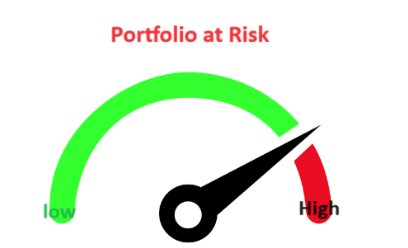There are numerous risks involved in the investment market. Many times, the actual return on the total investment is less than the expected return. Sometimes, you may also lose a major part of your original investment, which may affect your financial goals. This situation is called Portfolio at Risk.
There are various factors which cause this situation, such as market risk, liquidity risk, inflation risk, poor judgment, bad strategies, interest rate changes and much more. Let us read about portfolios at risk in this article and learn some major steps to keep them in check.
What is Portfolio at Risk?
A portfolio at Risk is a situation where loss of wealth and value of performance of an event decline due to a number of factors, such as market volatility, poor judgment, credit defaults, interest rate changes, fraud, currency fluctuations, etc.

Every investment option has its own risk and it is very much important to analyze the risk factors while creating your portfolio. Typically, higher-risk portfolios offer higher returns, while lower-risk portfolios provide moderate or lower returns.
If you are someone with a high-risk tolerance, then invest in more heavily high-risk instruments, such as equity. But if you are a low-risk investor, then opting for safer bonds, saving plans, fixed deposits, etc can be a good choice.
Portfolio at Risk: Key Takeaways
- A portfolio at risk is the possibility where investors experience losses due to various external factors that affect the performance of multiple investments.
- Some of the major factors are market volatility, poor judgment, credit defaults, interest rate changes, fraud, currency fluctuations, etc.
- Standard Deviation, Sharpe ratio, Value at Risk (VaR), Conditional Value at Risk (CVaR), Sortino Risk, etc are some of the methods used to calculate portfolio risk.
- Diversifications, hedging, portfolio management, and risk budgeting are some measures to control portfolio at risk.
What is the best way to Control Portfolio at Risk?
Every investment consists of risk, higher-risk portfolios can offer higher returns, and lower-risk portfolios provide lower or moderate returns. Managing risk is important when managing your profile to avoid major financial losses.
It is advised not to put your investment money in one instrument, but instead to invest in a variety of assets. Diversification is a proven strategy where investors invest in a variety of assets to reduce the risk in their portfolio.
Allocate assets among various asset classes, such as bonds, cash, stocks, etc., to create a consistent and ideal portfolio with risk tolerance. Let us look at some more portfolio management techniques below.
- Hedge Funds: It is a strategy using securities, such as futures trading, to limit the risk exposures of a portfolio. However, the reduction in risk by hedging also reduces the potential profits.
- Active Management: It is a strategy that involves making investment decisions based on various market conditions and dynamics. It is suitable for people who have the time and resources to analyze securities and make informed decisions.
- Portfolio Management: It involves managing various assets to maximize the return on investment while managing the risk. It uses various mathematical models to analyze different marketing scenarios and build the optimal portfolio.
- Risk Budgeting: The objective of risk budgeting is to create a portfolio across different asset classes with different investment strategies to create a profile after taking into account risk tolerance and investment goals.
Types of Portfolio Risk
Some of the major factors that determine portfolio risks are mentioned below.
1. Market Risk
There are many factors that affect the stock market, such as inflation, rate changes, geopolitical events, interest rates, recession, and economic conditions, which affect all major investments to some extent. It is also known as systematic risk and cannot be eliminated by diversification.
2. Credit Risk
Credit risk is the possibility of loss due to default by the issuer of a bond or other instrument. When borrowers fail to pay loans, credit risks occur. This is more frequent in corporate bonds. Here, issuer creditworthiness determines the value of a bond.
3. Liquidity Risk
This risk involves investment, which is difficult to sell to avoid more losses on any instrument. It can occur due to a lack of buyers in the market or if the instrument needs to be more liquid, such as real estate, private equity, private debt, etc.
4. Inflation Risk
In terms of inflation risk, prices of goods and services increase with time. Over time, the same amount of money will buy fewer goods and services due to price inflation. This also leads to a major loss of real value of money. The most affected investments are those with fixed return rates, such as bonds.
5. Currency Risk
Investors with international investments in foreign currency can suffer losses due to changes in exchange rates or other factors. It generally arises from a change in the price of one currency in relation to the other.
6. Reinvestment Risk
This risk arises from reinvesting funds at a lower interest rate than previous times. It might be possible that investors might not be able to reinvest cash flows at a rate comparable to the current rate, which leads to losses.
7. Concentration Risk
This investment risk occurs when all your funds are invested in a specific investment rather than distributed to various asset classes in different types of investments, industries, or geographical areas.
8. Political Risk
These risks aim to cause losses due to changes in government or their policies, regulations or instability in a particular part of the country.
How to Calculate Portfolio at Risk?
There are various methods for calculating risk factors in an investment. Let us check out some of the methods to calculate portfolio risks below.
1. Standard Deviation
With the help of standard deviation, we can calculate the dispersion of returns around the mean of an investor portfolio. It is widely used for measuring portfolios at risk and also represents the volatility of the portfolio. Check the formula below to calculate portfolio risk.
| σ = sqrt( (1 / (N-1)) * sum((x_i – μ)^2) ) |
Where:
σ (sigma) represents the standard deviation
N is the total number of samples
x_i is the value of the ith sample
μ (mu) is the mean of the sample.
2. Value at Risk (VaR)
VaR is a statistical method that quantifies the extent of financial losses in an investment, or portfolio over a time frame. It is calculated by taking into consideration the portfolio standard deviation, the rate of return and the individual rate of return and portfolio share.
If the 95% Value at Risk (VaR) for one month is $1 million, then there is 95% confidence that the portfolio will not lose more than $1 million over the next month.
3. Conditional Value at Risk (CVaR)
This is a risk measure method in which expected losses beyond a certain threshold or limit are calculated. an extension of value at risk (VaR) which signifies an expected shortfall.
4. Sharpe Ratio
It is one of the most widely used methods for measuring risk associated with returns of a portfolio. It compares the return on investment with its risk. It is given by the mathematical expression below
where:
Rp is the expected portfolio return.
Rf is the risk-free rate of return
σp is the standard deviation of the return on a portfolio.
5. Sortino Ratio
The Sortino ratio differs from the Sharpe ratio as it only considers the standard deviation of the downside risk of a portfolio rather than the complete upside and downside of risk. Mathematically, it is represented by
where:
Rp is the expected portfolio return
rf is the risk-free rate of return
σd is the standard deviation of downside risk
What is Portfolio Risk Management and Key Components?
Portfolio risk management is a method of identifying potential risks, such as market patterns, liquidity risk, inflation risk, poor judgment, bad strategies, interest rate changes and much more that could impact the overall performance of an investment portfolio.

Some of the key components of portfolio risk management are given below.
-
- Risk Identification: This stage involves identifying, documenting and understanding potential risks which could affect investor portfolios and returns.
- Risk Assessment and Measurement: After identification of risks steps are taken to determine the impact of these risks on financial objectives. Quantitative analysis is used for risk assessment and potential losses with risks are identified.
- Risk Mitigation and Strategies: In this stage, steps are taken to develop strategies to mitigate the risks involved. Frequent risk mitigation practices are risk avoidance, risk reduction, risk transfer, and risk acceptance.
- Risk Monitor and Review: The complete risk management of an investor profile requires regular monitoring and updates regarding the identified risks and mitigation strategies.
Learn Stock Market Fundamentals with PW Skills
Uncover the complexities of the stock market and its fundamentals with our interactive classes and expert mentorship in our Basics of Stock Market Course. Through the course, you will understand the significance of investment portfolios and equities.
- Self-paced learning with recorded lectures
- Interactive quizzes
- Seamless 24×7 support
- Get Certified
- Connect with a large community and learn
- Experienced faculty
Learn Market analysis, trading terminology, technical analysis, market trends, IPOs and their significance in making an informed decision in stock market investment only at pwskills.com
Portfolio at Risk FAQs
Q1. What is a portfolio at risk?
Ans: A portfolio at Risk is a situation where the loss of wealth and value of the performance of an event decline due to a number of factors.
Q2. What is portfolio risk management?
Ans: Portfolio risk management is a method of identifying potential risks that could impact the overall performance of an investment portfolio.
Q3. What is the definition of a portfolio in investment?
Ans: A portfolio is a collection of financial investments, such as bonds, stocks, commodities, cash, Exchange Traded Funds (ETFs), and other equivalents.
Q4. What are various methods of calculating portfolios at risk?
Ans: Standard Deviation, Value at Risk (VaR), Conditional Value at Risk (CVaR), Sortino ratio, Sharpe ratio, etc.

